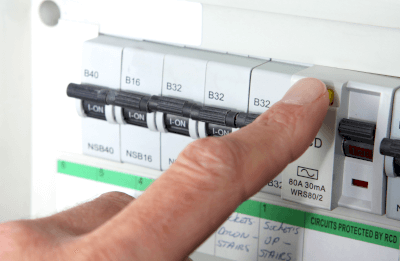What Is a Current-Limiting Fuse?

A current-limiting fuse is a type of safety device for electrical equipment.
When an accident occurs, such as a short circuit in an electrical circuit, an abnormally high current flows through the circuit, generating heat and possibly causing a fire. One method of avoiding this danger is to include a current-limiting fuse in the circuit.
When an abnormal current flows, the fuse element in the current-limiting fuse, a fusible metal element, heats up and melts, causing the circuit to open, thereby suppressing the abnormal current. The fused element is irreversible. Once a current-limiting fuse has served as a safety device, it must be replaced with a new fuse.
Uses of Current-Limiting Fuses
Since current-limiting fuses are safety devices against abnormal currents, they are used in a variety of applications, including home appliances, switchboards, and automobiles.
Especially in the automotive field, current-limiting fuses are in high demand as a safety device due to the increasing use of electronic components, such as engine control by microcomputers.
On the other hand, although current-limiting fuses have the advantage of being inexpensive to install, once the element blows, the user must replace it with a new fuse. For this reason, switch-type breakers are more common than current-limiting fuses. Especially as a safety device for interrupting abnormal currents in switchboards that need to be restored immediately after an overcurrent interruption.
Principle of Current-Limiting Fuses
Current-limiting fuses operate on the simple principle that when the current exceeds the rated value, the fuse’s element heats up, melts, and interrupts the circuit.
Since the thermal resistance of the element is higher at the center than at the ends, heat is conducted from the center to the ends. Under normal conditions, heat in the element escapes to both ends. However, if a current exceeding the rated current flows through the element, heat conduction cannot keep up, and the center of the element exceeds its melting temperature, causing it to shut down.
Current-limiting fuses not only interrupt the circuit when an abnormal current flows but must also pass the current during normal operation. Therefore, when selecting current-limiting fuses, consideration must be given to ensure that the steady-state current during normal operation is lower than the rated current.
In practice, the steady-state current must be less than the rated current plus a temperature derating that takes into account the steady-state derating specified by safety standards and the resistance temperature coefficient of the metal element.
In addition, it is important to select current-limiting fuses by measuring the pulse current and inrush current values of the equipment to be fused, and to test the actual equipment after selection to ensure that current fuses will not interrupt current values that are higher than the operating current of the electrical circuit but not abnormal, such as startup current and ON/OFF current. After selection, it is important to test the fuse on the actual equipment.